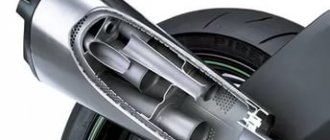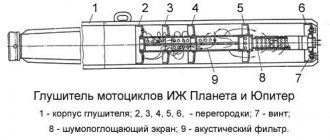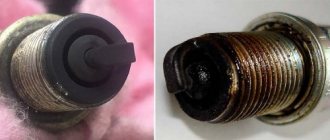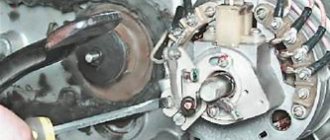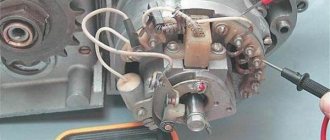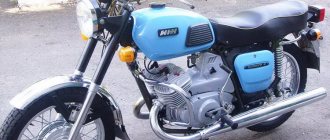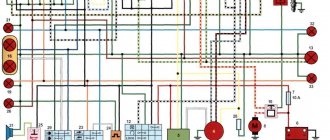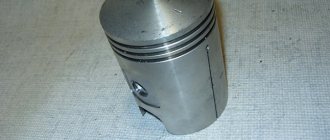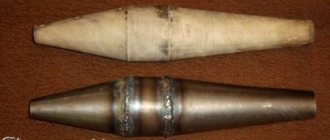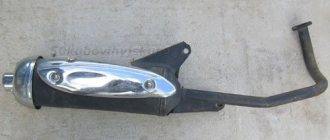IZH Planet 5 is a fairly unpretentious and easy-to-maintain motorcycle, but it happens that it may well break down. This article will help you identify problems with your motorcycle.
Before you start looking for problems in this motorcycle, it is worth studying at least a little theory, which will help you understand at least a little how the motorcycle’s power unit and its electrical equipment work.
Wiring diagram for IZH Planet 5, IZH Jupiter 5:
Engine design IZH Planet 5:
Design of the Planet 5-01 engine with clutch and gearbox (sectional view): 1 - spark plug, 2 - cylinder head, 3 - cylinder, 4 - piston, 5 - piston ring, 6 - piston pin, 7 - crankcase , 8 — roller bearing, 9 — left oil seal, 10 — motor chain, 11 — ball bearing, 12 — crankshaft sprocket, 13 — outer clutch drum, 14 — drive disk, 15 — driven disk, 16 — inner clutch drum, 17 — pressure disk, 18 — clutch spring, 19 — shaped nut, 20 — pusher, 21 — ball bearing, 22 — adjusting screw with locknut, 23 — hatch cover, 24 — trigger gears, 25 — spring, 26 — trigger shaft, 27 - cuff, 28 - reflector, 29 - shift mechanism shaft, 30 - installation sleeve, 31 - fork, 32 - stop, 33 - gearbox cover, 34 - right crankcase cover, 35 - gear shift fork shaft, 36 - ball bearing, 37 — intermediate shaft with gears, 38 — ball (5.556 mm), 39 — primary shaft with gears, 40 — secondary shaft nut cap, 41 — secondary shaft, 42 — cuff, 43 — secondary shaft sprocket, 44 — roller bearings, 45 — gearbox cover gasket, 46 — generator cover with stator, 47 — ball bearing, 48 — right oil seal, 49 — generator rotor, 50 — roller bearing, 51 — ignition system sensor, 52 — crankshaft, 53 — cylinder gasket, 54, 55 — needle bearings, 56 — cuff, 57 — protective washer, 58 — shaft with clutch release lever, 59 — return spring, 60 — thrust screw, 61 — clutch release pusher, 62 — clutch release piston, 63, 65 — vibration damper, 64 - decompressor
After familiarizing yourself with at least the basic terms of engine design and electrical circuitry, you will already be able to understand what needs to be done and where exactly.
Where to start troubleshooting?
First of all, check if there is any fuel left in the tank :). Even if it’s funny, in most cases it happens that the biker simply forgets about this, albeit simple, but quite common reason. Next, you need to make sure that gasoline flows into the gas tap and from there enters the carburetor. This is easy to do, just remove the fuel pipe that goes from the gas tap to the carburetor; if gasoline flows, then there is gasoline!
Now you should unscrew the spark plug and check for a spark. To do this, without removing the high-voltage cap from the spark plug, lean the spark plug against the cylinder and crank the engine several times with the kickstarter. If there is a spark, then the reason should be looked for elsewhere. If there is no spark, then you need to check the ignition coil, switch, wiring and of course the generator. Sometimes the spark is too weak to ignite the mixture in the cylinder; this may be caused by a worn ignition coil, incorrectly configured ignition and, of course, the switch.
If you have contact ignition on the Planet, then you should definitely remove the right cover and check the ignition settings. Have you ever encountered ignition problems before? There is nothing to worry about, everything needs to be learned! Here's a video on setting up the ignition on IZH Planet 5:
The work is not difficult and even a schoolchild who is not familiar with ignition can do it. The main thing is desire and the right attitude. It happens that the ignition is contactless, in which case you are very lucky, because contactless ignition is not only convenient and reliable, but also simple. Setting it up will take you a minimum of time and effort.
If your motorcycle is equipped with a contactless engine starting system, then there is no need to set gaps, since the moment of spark formation can be determined using a special tester. In this case, to install the ignition on Izh Planet 5, you will need:
- install the device correctly to measure voltage (up to 20 volts);
- connect the device to the 2nd and 3rd contacts of the Hall Sensor.
A motorcycle shoots into the muffler - problem solving
Owners of motorcycles not only made in Russia, but also of foreign cars often face the problem of “shooting” from the muffler. This happens due to improper care of the air-fuel mixture ignition system. The motorcycle shoots the muffler in several cases:
- when using low-quality gasoline;
- malfunction of the electronics system responsible for fuel supply;
- gasoline does not enter the combustion chamber in pure form;
In such cases, you don’t need to wonder why the muffler on a motorcycle shoots. Poor quality gasoline has a very high combustion temperature due to the addition of water, so it does not ignite completely. The remaining drops fall on the walls of the heated muffler . Their ignition creates pops.
The motorcycle also shoots into the muffler when releasing the gas. The lower the pressure created in the internal combustion chamber, the more droplets enter the muffler. On some bikes, fuel accumulates in the muffler, followed by rare but very loud bangs.
Most often, but not always, owners of the Russian motorcycle industry face this problem. For example, a Ural motorcycle shoots into the carburetor. This occurs due to direct clogging of gasoline in the carburetor itself. To avoid this problem, it is necessary to constantly clean the filters and change the consumables responsible for cleaning the engine. Proper operation of your bike will not only ensure good engine performance, but will also maintain factory specifications.
Why is Izh Jupiter 5 sneezing?!
HOW THE IZH Jupiter5 SHOOTS Shoots at the carburetor - how to set it upRead more
The right cylinder on the Izh Jupiter 5 motorcycle does not work | The cylinder on a motorcycle does not workRead more
IZH JUPITER 5 What to do if the cylinder failsRead more
Izh Jupiter, at high speeds sneezes into the carburetorRead more
Cylinder failure on IZ Jupiter 5Read more
IZH JUPITER 5 - 3 REASONS WHY IT STARTS AND DRIVES BADLY / WHAT NOT TO DO / MY EXPERIENCERead more
Izh Jupiter 5 will not start. SolutionsRead more
Why does the right boiler of Izh Jupiter sneeze and not drive in 2nd gear? More details
Java 638, troits at high speeds, sneezes, reasons. Read more
Why does Izh Jupiter 5 sneeze?! Read more
Izh Planet 5 is sneezing. What is it? Read more
°First attempts to start an Izhak°After repairing the wiring at BSZ, he farts and sneezesRead more
What do the shots affect?
Problems with the ignition system do not bode well. In such a situation, with prolonged engine operation, not only the aesthetic impression can deteriorate. A dirty carburetor or low-quality fuel will eventually disrupt cylinder compression, which in turn will lead to engine failure.
To understand why a Ural motorcycle shoots at the muffler, or any other bike, you should check the problem areas. Here are possible ones:
- not tightness of the pipes that can suck in air, or the exhaust tract;
- faulty spark plugs;
- dirty air filters or carburetor;
- difficulty in supplying fuel;
However, the problem may also be with the racers' rev limiter. The spark plugs do not charge continuously, causing most of the mixture to go straight into the exhaust system, where it hits the hot metal and ignites, creating a loud bang. A clear example of such a process is a motorcycle equipped for special show programs. On such bikes, some of the fuel mixture ignites directly in the exhaust pipe, which is why you can see a flame coming out of the muffler.
Under no circumstances should you install forward flow if you experience popping noises. This will only increase the noise in the exhaust system. This happens due to an even greater depletion of the fuel-air mixture and a “gutted” muffler.
In conclusion, we highly recommend watching a competent video about problems in the engine, where, among other things, the issue of shots into the muffler is covered in sufficient detail.
Source of the article: https://motoholder.ru/poleznoe/strelyaet-v-glushitel
Izh Jupiter 5 sneezes the right cylinder into the muffler
FAQ If your car won't start.
Don’t be lazy, read this topic to the end, all the problems have already been raised more than once. So, the engine does not start for 3 reasons: mixture, compression, ignition. 1) Check the compression. If it is below 4-5, then it’s simply useless. The norm is about 8 (see manual). 2) Check for the presence of a spark on the spark plug. We set the ignition timing according to the manual. Then we’ll adjust it while it’s running. 3) Install new spark plugs and add fresh gasoline. We adjust the carb to the recommended settings (1.5-2.5 turns of the screw xx, the needle is in the middle position). 4) Pour a couple of gasoline cubes under the candle. Gotta grab it. If it doesn’t catch, we read about ignition. (see below). 5) If it grabs it, but doesn’t start, it’s a mixture. First, let's try to adjust the carb (see below). You can play around with the enrichment a little. Don’t forget about the fuel level in the chamber. It didn’t help - we’re looking for an air leak. Can suck through a broken carb or through “pants”. It didn’t help - we’re thinking about oil seals. If the oil seal is leaking, most likely only one boiler will malfunction, oil will leak from the box, and a “puddle” may form at the bottom of the crank chambers. The following describes specific typical faults and methods for eliminating them. Kickstart lever skips or does not return (slowly returns) to its original position
1. Rotating the kickstarter lever on the shaft Tighten the bolt securing the lever; if the splines are severely damaged, replace the lever or shaft 2. In cold weather, too viscous oil was poured into the gearbox. Replace the oil corresponding to the ambient temperature (viscosity according to SAE 5W30; 10W30) or, as a temporary 3. Chips or severe wear of the sector teeth, ratchet or trigger gears Replace damaged parts, be sure to wash the gearbox 4. The gear is stuck on the clutch drum hub Eliminate the jamming, dull the sharp edges of the gear hole 5. The trigger spring has burst or weakened Replace the spring 6. The retaining ring has come off the clutch drum hub Replace the ring or drum
1. The ignition is turned off by the emergency switch. There is no spark on the spark plug Turn on the ignition 2. There is no fuel in the tank Fill the tank 3. On a cold engine the starting device (fuel corrector) is not turned on. Turn the fuel corrector lever, if necessary, eliminate the drive malfunction (jamming of the corrector cable or plunger). After starting and warming up the engine, return the corrector lever to its original position 4. Fuel does not flow into the carburetor due to clogged filters or valve channels (there is no stream of fuel from the hose removed from the carburetor and the fuel valve is open) Remove the valve, disassemble and wash everything in solvent parts, blow out the channels and the fuel hose with compressed air. After installing the tap and connecting the hose to the carburetor, press the float quencher to fill the carburetor float chamber 5 with fuel. There is no spark on the spark plug due to it being oiled with the fuel mixture, poor contact between the tip of the spark plug and the high-voltage wire, or another malfunction of the spark plug. Fuel condensate has accumulated in the crank chamber of the engine, which leads to over-enrichment of the combustible mixture and the impossibility of its ignition. By turning off the fuel supply and opening the decompressor valve, blow out the crank chamber and cylinder with several slow movements of the kick-starter lever. If this does not help, remove, clean or replace the spark plug. Ensure reliable contact in the connection of the high-voltage wire with the tip of the spark plug 6. Other elements of the ignition system are faulty or the contact between them is broken (no spark on the spark plug). Check the high-voltage wire, ignition coil, capacitor, operation of the breaker contacts, setting the ignition timing, fuse one by one and battery charge, ignition switch. Replace faulty elements, ensure reliable electrical contact between them. If necessary, adjust the ignition timing, check the level and density of the electrolyte, clean the surface, terminals and terminals of the battery, charge or replace the battery 7. The throttle valve (its drive) or the carburetor needle valve is stuck, the fuel jets and carburetor channels are clogged, in particular the starting channels devices. Wash the carburetor parts in a solvent and blow out the channels with compressed air, repair and adjust the carburetor, as well as the throttle valve drive.
The motorcycle shoots into the muffler: why does this happen and how to solve the problem?
On domestic motorcycles, a problem often arises associated with the appearance of loud sounds in the muffler. Even drivers of foreign vehicles often suffer from “machine gun bursts” that accompany a sharp increase or decrease in speed. Getting rid of this trouble can be quite difficult. However, if you understand why a motorcycle shoots its muffler, you can eliminate loud noises that disturb public peace.
The essence of the problem
Most often, loud pops in the muffler of two-wheeled vehicles are heard when a lean mixture is supplied to the engine. The reason for its formation may be the use of low-quality gasoline, saturated with water and non-flammable impurities, or incorrect adjustment of the intake system. The air-fuel mixture burns only partially - its remains splash out into the hot muffler, where they explode with sharp, unpleasant sounds. A symptom of a lean mixture is popping sounds in bursts, which intensify as the speed increases.
In powerful motorcycles, the completely opposite problem is more common, associated with the supply of an excessively rich mixture. There is not enough oxygen for its combustion, which leads to the deposition of gasoline condensate on the walls of the muffler. When the “critical mass” is reached, the fuel outside the engine ignites, resulting in one loud bang. If the problem is not corrected, within 1–2 months the contents of the muffler will simply burn out and it will turn into a “direct flow”.
Carburetor of Izh Planet Sport motorcycle
Motorcycle Izh Planet Sport 350. A legend of the Soviet motorcycle industry. Early models of the motorcycle were equipped with Japanese components, in particular a Mikuni carburetor with a diffuser diameter of 32 mm. Thanks to him, the motorcycle's power was 32 hp. at 6700 rpm.
The reliability of the carburetor is explained by the simplicity of the design. The throttle has a cylindrical shape. To drain excess fuel, there is a special plug at the bottom of the float chamber. The carburetor is adjusted using an air screw and an idle screw (similar to the K-68). To make starting the engine easier in cold weather, there is an enrichment lever.
Later versions of the motorcycle began to be equipped with the domestic K-62M carburetor. The engine power with it dropped to 28 hp.
As you can see, different carburetors were installed on Izh motorcycles of the Planet line, but mostly domestic ones. As engine power increased, the characteristics of carburetors also changed. For high-quality and long-term engine operation, it is necessary to inspect and clean the carburetor in a timely manner (every 3000-4000 km). If desired, imported carburetors can be installed on Izh Planet motorcycles. The main thing is to choose the right jets with the required throughput and match the diameter of the diffuser.
Carburetor in a motorcycle
It happens that the motorcycle shoots into the muffler and carburetor - this is often found on domestic Urals and imported choppers with a large cylinder capacity. The problem is a clogged air-fuel mixture at the inlet. To eliminate it, it is worth changing the filters and sealing gaskets, and also checking how tightly the pipes fit to the inlet fittings and whether there are any large cracks in them.
Very often, popping noises appear after replacing the muffler with a non-standard one or cutting holes in it to eliminate resistance to escaping exhaust gases. Particularly unpleasant sounds appear when installing a “direct flow”. The reason is the creation of a strong vacuum, which leads to a lean air-fuel mixture. Powerful imported motorcycles often use an exhaust gas afterburning system, which reduces their toxicity - after removing the standard muffler, its operation becomes clearly audible. To eliminate shots after changing the silencer, you must:
- Reconfigure the carburetor or reflash the control unit.
- Install filters with a different capacity.
- Disable the exhaust gas afterburning system.
On sports motorcycles whose engines run at high speeds, the problem with shots may be related to the speed limiter or crankshaft speed limiter. When a certain indicator is reached, the fuel supply may remain unchanged for some time, while the number of flares is reduced. Accordingly, a huge amount of gasoline enters the muffler, which explodes with a jerky sound, forming a “machine gun burst.” It can be heard especially well when releasing the gas after active acceleration. It is impossible to eliminate such a problem without reducing the life of the engine - you have to change your driving style so as not to irritate yourself and others with unpleasant loud bangs.
Source of the article: https://molotatv.ru/statii/pochemu-motocikl-streljaet-v-glushitel
Carburetor of Izh Planeta 3.4 motorcycles
Izh Planet-3 motorcycles were equipped with K-62P and K-36I carburetors. The latter had a unique design for its time. The throttle shape was U-shaped, which made it possible to significantly reduce the dimensions of the carburetor (in comparison with the K-28 and K-37 produced at that time). The corrector was moved out of the diffuser area and regulated not the air, but the fuel. This solution made it possible to reduce fuel consumption by 4-6% due to more stable mixture adjustment.
The mixing chamber cover was fastened with special locking springs, which made it possible to quickly and conveniently replace the throttle cable or rearrange the needle. The main fuel jet was screwed into the bottom of the carburetor next to the drain plug. To clean it, it was not necessary to dismantle the carburetor. The diameter of the diffuser of the K-36I carburetor at the outlet is 28 mm, and in the middle it is 26 mm. That is, the mixing chamber is a kind of aerodynamic profile, which has a beneficial effect on mixture formation.
Another feature of the K-36 carburetor is its operating principle, which is similar to a car carburetor. The screw for the amount of mixture in it regulates not the air, but the fuel emulsion entering behind the throttle. Due to this, the sensitivity of the carburetor settings at idle has increased. Adjustment is carried out with screw 1 for the quantity of the mixture (at an angle) and screw 2 for the quality.
The K-36 carburetor has one drawback. It is sensitive to road dust. The upper latches do not seal the lid of the mixing chamber tightly and dust particles get there, the valve begins to jam and wear out. That is why motorcycles on which such carburetors were installed (Kovrovets, Izh Planeta-3, etc.) were equipped with carburetor protective covers.
Later, new K-62 carburetors with the indices I, P, B began to be installed on the Izh Planet-3, 3-01 and 4 motorcycles. The power of two-stroke engines grew and there was a need to increase the diameter of the diffuser (now it was 32 mm), throughput jets, etc.
The new carburetor design made it possible to uninterruptedly supply the engine during sudden braking and acceleration, tilting and rolling of the motorcycle.
Setting up such a carburetor is carried out similarly to the K-68 setting described above. The quantity screw is not located on the side of the carburetor, but in the upper part.
The essence of the problem
Most often, loud pops in the muffler of two-wheeled vehicles are heard when a lean mixture is supplied to the engine. The reason for its formation may be the use of low-quality gasoline, saturated with water and non-flammable impurities, or incorrect adjustment of the intake system. The air-fuel mixture burns only partially - its remains splash out into the hot muffler, where they explode with sharp, unpleasant sounds. A symptom of a lean mixture is popping sounds in bursts, which intensify as the speed increases.
In powerful motorcycles, the completely opposite problem is more common, associated with the supply of an excessively rich mixture. There is not enough oxygen for its combustion, which leads to the deposition of gasoline condensate on the walls of the muffler. When the “critical mass” is reached, the fuel outside the engine ignites, resulting in one loud bang. If the problem is not corrected, within 1–2 months the contents of the muffler will simply burn out and it will turn into a “direct flow”.
Incomplete combustion of the mixture may be caused by a malfunction of the ignition system. In the absence of a spark, the cylinder misses a power stroke and the full amount of gasoline enters the muffler. Loud sounds are most often heard in this case at high speeds. The problem is also fraught with complete burnout of the muffler from the inside. Misfires are often accompanied by beautiful visual effects - when the engine is overloaded, jets of flame fly out of the exhaust pipes.
Another option is a lean mixture in the intake system caused by air, dirt or water getting into it. Naturally, the fuel does not burn completely and drops of gasoline form on the walls of the muffler, burning with a sharp, characteristic sound. In any case, the motorcycle malfunction must be repaired as soon as possible so as not to encounter more serious repairs.
Reason and solution
The easiest way to get rid of pops on a carburetor motorcycle is to simply move the needle valve to a different position, changing the degree of saturation of the mixture with gasoline. It is better to entrust this operation to a specialist, since not everyone can fine-tune the carburetor. If there is electronic fuel injection, it is impossible to change the gasoline supply parameters yourself - the control unit will have to be flashed at a specialized service station.
It happens that the motorcycle shoots into the muffler and carburetor - this is often found on domestic Urals and imported choppers with a large cylinder capacity. The problem is a clogged air-fuel mixture at the inlet. To eliminate it, it is worth changing the filters and sealing gaskets, and also checking how tightly the pipes fit to the inlet fittings and whether there are any large cracks in them.
Very often, popping noises appear after replacing the muffler with a non-standard one or cutting holes in it to eliminate resistance to escaping exhaust gases. Particularly unpleasant sounds appear when installing a “direct flow”. The reason is the creation of a strong vacuum, which leads to a lean air-fuel mixture. Powerful imported motorcycles often use an exhaust gas afterburning system, which reduces their toxicity - after removing the standard muffler, its operation becomes clearly audible. To eliminate shots after changing the silencer, you must:
- Reconfigure the carburetor or reflash the control unit;
- Install filters with a different capacity;
- Disable the exhaust gas afterburning system.
Adjusting the K-68 carburetor on the IZH Planet-5 motorcycle
The K-68I carburetor was installed on the Izh Planet-5 motorcycle more often than others. With proper setup and proper care, the motorcycle starts quickly, runs smoothly and without complaints.
To adjust the K-68I carburetor you will need a flat-head screwdriver, pliers, and a ruler. For clarity and ease of adjustment, use the K-68 carburetor diagram.
Algorithm for adjusting the Izh Planeta-5 carburetor:
- The first step is to check the fuel level in the float chamber. Unscrew the camera cover bolts with a screwdriver and remove it. Turn the carburetor over and use a ruler to measure the distance from the carburetor body to the top edge of the floats. It should be 26 ± 5 mm. If the parameters deviate, the tongue of the floats is bent in the appropriate direction using pliers. At the same time, in no case should the parallelism of the floats be disrupted.
- Set a gap of 2 mm between the throttle valve and the bottom of the mixing chamber by adjusting screw 11. Then check the position of the throttle needle. The required needle position is the middle groove. The remaining grooves are made to move the needle lock and adjust the appropriate fuel quality depending on climatic conditions.
- After all the above steps, we proceed to the most important stage - setting the idle speed. The idle quality adjusting screw 15 (located vertically on the left side of the carburetor) is screwed in until it stops, and then unscrewed 1-1.5 turns. Start the engine and warm up for 5 minutes. Using the mixture quantity adjustment screw 11 (located horizontally on the left side of the carburetor), we set the minimum stable engine speed. At the same time, slowly unscrew screw 15 until the engine speed stops increasing. It is the moment of reducing the crankshaft speed that will be optimal for determining the position of the adjusting screw 15. We again reduce the engine speed with screw 11 and unscrewing screw 15, we find a new optimal position of the throttle valve. This operation must be repeated until the minimum, but at the same time stable, engine crankshaft speed is established.
- By sharply turning the throttle lever at idle, we check the correctness of the adjustment (the quality of the mixture). If, when the throttle is opened sharply, the engine stalls or picks up speed poorly, screw 15 needs to be tightened a little, thereby enriching the mixture. If the engine stalls when the throttle is closed, screw 15 should be unscrewed slightly.
- You can also check the correctness of the adjustment by the color of the central insulator of the spark plug. After adjusting the carburetor, drive a motorcycle for a distance of 5-10 km and remove the spark plugs from the cylinder head. Dark carbon deposits indicate that the mixture is too rich. A light color (whitish or sandy) indicates that the mixture is poor. The normal recommended candle color is brown or brick.
- It is also worth remembering that the free play of the throttle cable is 1-3 mm. If it is not there, the throttle adjustment will be incorrect. The free play is set by adjusting a special bolt located under cap 18.
The video below clearly shows the adjustment of the K-68I carburetor on the Izh Planet-5 motorcycle.
Quick diagnostics
Since in the future the problem of popping noises in the muffler can lead to breakdown of the engine and other important components of the motorcycle, it needs to be solved as quickly as possible. You should consistently check the performance of systems such as: intake, ignition, exhaust. All damaged parts are replaced with new ones, connections are sealed. It is also better to temporarily replace tuning components with “stock” ones to check how the engine will perform with factory settings. If all else fails, the motorcycle should be inspected by a professional mechanic, who will find the cause and tell you how to eliminate it at minimal cost and without reducing the life of the power unit.
Source of the article: https://www.motoshkoli.ru/article/bike/mototsikl_strelyaet_v_glushitel
shoots through a silencer
shoots through a silencer
Post by Nickita » 23 Feb 2012, 15:01
Re: Shoots through a silencer
Post by Nickita » 23 Feb 2012, 15:56
Re: Shoots through a silencer
Post by Pobedovod » 23 Feb 2012, 16:04
Re: Shoots through a silencer
Post by Nickita » 23 Feb 2012, 16:08
Re: Shoots through a silencer
Post by Sniper » Feb 23, 2012, 4:27 pm
Re: Shoots through a silencer
Post by Nickita » 23 Feb 2012, 16:30
Re: Shoots through a silencer
Post by Nickita » 23 Feb 2012, 17:58
Re: Shoots through a silencer
Post by Pobedovod » 23 Feb 2012, 20:32
Re: Shoots through a silencer
Post by Nickita » 24 Feb 2012, 03:26
Re: Shoots through a silencer
Post by Nickita » Feb 25, 2012, 11:47 am
Damn, I checked everything that I could, the spark plug wire is normal everywhere, I tightened up the gaskets on the carb under the carb pipe, I even changed the purge windows, I took off and looked at new gaskets, I did it, I just didn’t change the coil, there is no other carb, a new one, clean in a week, it couldn’t have gotten clogged)
once it started up perfectly without any interruptions, worked until the gas in the carb ran out and stalled, well, I think, thank God, I put on the tank (I checked that there was nothing shorting under it) and again it won’t start, it just shoots either into the carb or into the plugs, but there is no recoil from the legs checked the ignition
Source of the article: https://www.motoizh.ru/forum/viewtopic.php?t=26681

